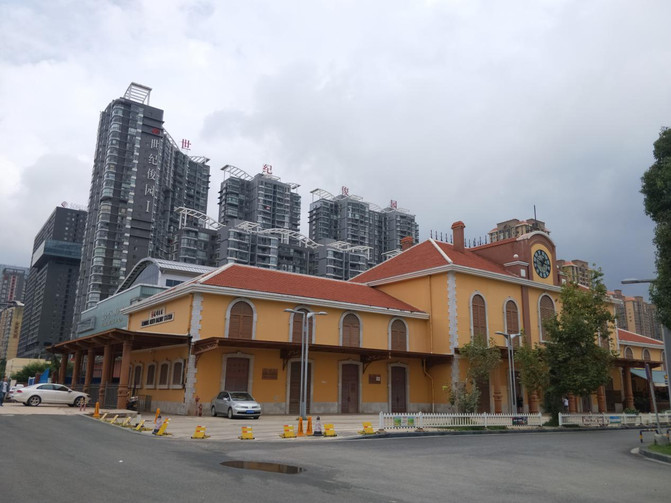Coming from the depths of the railway tracks, Yunnan Railway Museum
China is so big, I want to visit it. Take you to a place you have been or have not been.
Coming from the depths of the railway tracks, Yunnan Railway Museum

Yunnan is located on the southwest border of the motherland, with overlapping mountains and continuous rivers. The Yunnan Plateau has continued the transportation and trade mode of "ringing bells between the mountains and coming from horses" for thousands of years. In the spring of 1910, the first railway was born in Yunnan. Over the past 100 years, it has written a unique history of "three tracks parallel" of meter-gauge, inch-gauge and quasi-gauge railways.


Yunnan Railway Museum is an industry-oriented special museum with the theme of the history of Yunnan railway construction and development. It is one of the three major railway museums in mainland China.
Kunming North Railway Station, a yellow French-style building, is the starting point of the Yunnan Section of the Yunnan-Vietnam Railway (now the Kunming-Hekou Railway). This is the South Pavilion of the Yunnan Railway Museum.



When the Sino-French War ended in 1885, the French covet China while invading Vietnam and operating the Indona colony. In 1897, France forced the Qing government to "definitely allow candidates for railways from the Baise River area or the upper reaches of the Red River from the border with Vietnam to reach the provincial capital, which will be gradually surveyed and handled by China." In 1903, the Qing government and France formally signed the "Charter of the China-France Dian-Vietnam Railway", recognizing France's concession to build and operate railways in Yunnan, China.

In 1910, the meter-gauge Yunnan-Vietnam Railway, which went directly from Haiphong Port in Vietnam to Kunming, Yunnan, was opened to traffic. "Trains are not allowed to connect domestic and foreign countries." The railway is formed by the condensation of French capital and technology and the blood and lives of Chinese workers. It promoted the transformation of ancient Yunnan from traditional farming civilization to modern industrial civilization.



Looking out from the door of the Yunnan-Vietnam Railway built by the French, Yunnan people have seen the surging wave of the times in the world and felt the tremendous power of science and technology. At the same time, they have fought for their own rights of way, built their own railways, developed the national economy, and resisted The awareness of foreign investment plunder is also awakening. Based on the mainland, learning from the West, issuing stocks and bonds, and adhering to the principle that "non-nationals are not allowed to hold them", after 21 years of hardship from 1915 to 1936, they raised funds to build a 177-kilometer-long "Gebishi Inch-gauge Small Railway"(Gejiu-Bisazhai-Shiping). The gauge of the inch rail is only 600 mm, less than half of the gauge rail (1435mm).
(10-ton inch-gauge wooden flatbed truck, national first-class cultural relic)


The north hall of the museum is a modern building, and the north and south halls are connected by an aerial corridor. The museum houses many precious locomotives from Japan, the United States, France, Germany and other countries, including many national-level cultural relics.
Standard gauge upstream steam locomotive was built in Tangshan in 1971.


The meter-gauge Dongfanghong 21 diesel locomotive was manufactured in Qingdao in 1978.

The standard gauge Dongfeng 1 and 2 diesel locomotives were both products from the 1960s and 1970s and have served China's railways for more than 40 years.


The Myanmar Railway presented our country's German-made tourist buses as a diplomatic gift.

The Spring City EMU was specially developed when the World Horticultural Exposition was held in Kunming, China in 1999. It runs as a tourist train between Kunming and Shilin. The Chuncheng EMU was a pioneer in China's early exploration and manufacturing of high-speed EMU.

The meter-gauge steam locomotive manufactured by Kawasaki Shipyard in Japan in 1897 was in service on the Yunnan Railway from 1958 to 1985.


The meter-gauge wooden passenger car produced in France in 1940 and carried 52 passengers was discontinued in 1985.

The SN-type inch gauge steam locomotive produced in 1923 by the Bowen Locomotive Plant in Philadelphia, USA, was used on the Gaibi Railway and was stopped in 1991.


The Michelin meter-gauge diesel passenger EMU can be called the "treasure of the museum". It was a commercial vehicle driving on the Yunnan-Vietnam Railway at that time, and its white paint was particularly conspicuous.


Made in France and used on the Yunnan-Vietnam Railway since 1914. It was the most advanced diesel EMU in the world at that time. In 1932, the French company Michelin equipped each wheel tread with Michelin rubber tires that could be automatically inflated or artificially inflated, hence the name Michelin locomotive.

Rubber tires have good shock absorbers during driving, have low noise, and are equipped with soft seats and hard seats. They also have a washroom, toilet, and kitchen and dining room. The decoration is luxurious, like a fully functional mobile hotel. It is comfortable to ride and is not open to ordinary people., only carrying French technicians and senior officials from China and France.

Michelin locomotives reached 100 kilometers per hour in 1914, while steam locomotives on the Yunnan-Vietnam Railway at that time could only run at 15-20 kilometers per hour."Trains are not as fast as cars."
In 1984, the Michelin bullet train was abandoned due to lack of spare parts. Currently, there are only two groups of "Michelin" internal combustion locomotives in the world, and the other group is in France.
Previous Article:The forest hot spring behind the Golden Temple in Kunming is a pleasant day for the May Day Beer Barbecue Festival, without routine
